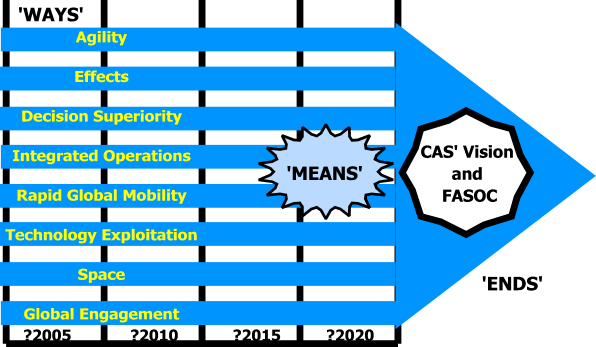Difference between revisions of "Royal Pinguinian Air Force"
(→Development Plan) |
(→Development Plan) |
||
| Line 44: | Line 44: | ||
'''Diagram for development''' | '''Diagram for development''' | ||
| − | + | http://i26.photobucket.com/albums/c139/Iron_1984/Pinguinum/military/Diagram001av.png | |
| − | |||
The RPAF Development Plan incorporates CAS’s Strategic Priorities and converts RPAF Strategy into Tasks. It does so through prioritised Development Objectives that articulate those intermediate outcomes within the Strategic Themes that will enable the Service to secure the ‘MEANS’ needed for implementation of the Strategy. | The RPAF Development Plan incorporates CAS’s Strategic Priorities and converts RPAF Strategy into Tasks. It does so through prioritised Development Objectives that articulate those intermediate outcomes within the Strategic Themes that will enable the Service to secure the ‘MEANS’ needed for implementation of the Strategy. | ||
The Purpose of the Development Plan | The Purpose of the Development Plan | ||
| Line 52: | Line 51: | ||
The execution of the RPAF Development Plan sits within the Strategy Battle Rhythm, and is the mechanism that enables Executive direction over the conversion of RPAF Strategy into Tasks. Its purpose is to ensure a coherent approach in the pursuit of developing air power capability for Defence; in so doing, it provides focus on the priorities within the Plan and, importantly, it creates alignment on a range of issues throughout the RPAF. The relationship between the Services, Policy and force development activities, and the MOD organisation, means that the RPAF Development Plan will be used for 2 main purposes: first, to focus RPAF resources on development tasks; and second, to influence future MOD planning rounds by | The execution of the RPAF Development Plan sits within the Strategy Battle Rhythm, and is the mechanism that enables Executive direction over the conversion of RPAF Strategy into Tasks. Its purpose is to ensure a coherent approach in the pursuit of developing air power capability for Defence; in so doing, it provides focus on the priorities within the Plan and, importantly, it creates alignment on a range of issues throughout the RPAF. The relationship between the Services, Policy and force development activities, and the MOD organisation, means that the RPAF Development Plan will be used for 2 main purposes: first, to focus RPAF resources on development tasks; and second, to influence future MOD planning rounds by | ||
| − | + | * Ensuring that the Policy, Concepts, Force Development and Equipment Capability communities understand the contribution that air power can make to Defence and the opportunities that exist for future force planning. | |
| − | + | * Ensuring that the RPAF community understands in detail the contribution that air power can make to Defence and the RPAF sponsored priorities for development of that capability. | |
| − | + | * Enabling RPAF staff involved in future capability work to act as convincing advocates for air power who can consistently and coherently represent the RPAF position in respect of developmental direction and priorities. | |
==The role of Air Power== | ==The role of Air Power== | ||
Revision as of 17:16, 1 October 2007
The high flying air force of the Piguinian Kingdom is suited to its needs. It brings tactical control and skilled aviating to the skies.
The RPAF amkes up one-third of the Pinguinian military.
Contents
Purpose
Chief of the Air Staff
Over the last 10 years the Royal Pinguinian Air Force has undergone significant change. We have made tremendous progress towards ensuring a capable and efficient force structure, which is able to cope with the unpredictable and complex security environment that exists today, and is likely to exist in the future. I believe that we now have a balanced Air Force, which is structured and orientated towards a multitude of operations. I intend, therefore, to build on the firm foundations set by my predecessors, consolidating where appropriate, whilst still ensuring that we are sufficiently agile to adapt to emerging threats, and the opportunities offered by new concepts and technologies. Our objective in all this is to provide rapid, precise effects across the entire spectrum of operations, from high intensity warfighting to support operations.
Agility is at the heart of our operational capability. But we also need to be sufficiently adaptable to keep pace with changes in the security environment, and our equipment needs to have the embedded flexibility to be capable of meeting new demands. As a consequence, single role platforms will, I believe, become increasingly something of the past; multi-role must be the way forward. We must also make sure that we have the right people to support the frontline and ensure that they are just as agile and adaptable as our equipment.
Strategy
Strategy Priorities
In order to deliver the Royal Pinguinian Air Force Vision we must develop our speed and accuracy in analysing and delivering effects, underpinned by innovative and imaginative solutions resulting in reliable and effective decision-making at the lowest appropriate level. Strategy Priorities for the Royal Pinguinian Air Force over the next 5-10 years are to:
- Support current operations
- Maintain and further develop an agile, adaptable and capable expeditionary air power contribution to Pinguinum's overall Defence capability, which takes full account of emerging threats, concepts and technologies
- Improve the accuracy, speed and coherence of our ability to deliver effects across the battlespace by developing and exploiting the Pinguinum's network enabled capability
- Introduce Hawk into operational service and, as swiftly as possible, provide the aircraft with a robust all-weather multi-role capability
- Harmonize our air power capability, concepts and doctrine with those of the FWA Forces
- Ensure our structures, organization and processes deliver rapid and accurate decision making at the lowest appropriate level
- Provide a World-class flying and ground training system and improve through-life education and training to produce well-motivated, highly trained, agile and adaptable warfighters
- Develop a sustainable manning and personnel strategy that supports the RPAF's expeditionary capability and takes account of the prevailing social environment
- Improve the quality of the RPAF’s operational, technical and domestic infrastructure
- Optimize investment in the RPAF by delivering the outcomes of the Defence Airfield Review, further exploiting the benefits of the Defence Logistic Transformation Process, building a strong relationship with Industry, and eliminating waste and bureaucracy across every strand of RPAF activity
- Further enhance the image and reputation of the RPAF with the public as a means of maintaining their enduring support and meeting our recruiting requirements
- Improve our people's ability to clearly articulate the contribution that air power - and the RPAF - makes to Pinguinum's Defence
Development Plan
The Royal Pinguinian Air Force Development Plan
The Royal Pinguinian Air Force Development Plan is the means through which Transformation is managed. The AFBSC 2-star group has ownership and maintains oversight of the Development Plan, reporting progress annually to the AFBSC. The Development Plan sets out the key objectives on the Royal Pinguinian Air Force Strategic Themes out to the Defence Planning horizon (20 years). It is being reviewed in 2006 to reflect the FASOC and the Royal Pinguinian Air Force Strategy. An explanation of how the Royal Pinguinian Air Force Strategy is articulated in the Development Plan; with oversight is shown below: The Strategy Framework
The development of the RPAF is to be coordinated within a framework described by the RPAF Strategy. Within the RPinguinianAF Strategy, Chief of the Air Staff’s (CAS) Vision and the Future Air and Space Operational Concept (FASOC) beacon represent the ‘ENDS’ or outcomes that are sought out to 2025. The 8 Strategic Themes described by the RPAF Strategy, and illustrated below, represents the ‘WAYS’ or paths that will ensure actions are directed coherently towards the Ends.
Diagram for development

The RPAF Development Plan incorporates CAS’s Strategic Priorities and converts RPAF Strategy into Tasks. It does so through prioritised Development Objectives that articulate those intermediate outcomes within the Strategic Themes that will enable the Service to secure the ‘MEANS’ needed for implementation of the Strategy. The Purpose of the Development Plan
The execution of the RPAF Development Plan sits within the Strategy Battle Rhythm, and is the mechanism that enables Executive direction over the conversion of RPAF Strategy into Tasks. Its purpose is to ensure a coherent approach in the pursuit of developing air power capability for Defence; in so doing, it provides focus on the priorities within the Plan and, importantly, it creates alignment on a range of issues throughout the RPAF. The relationship between the Services, Policy and force development activities, and the MOD organisation, means that the RPAF Development Plan will be used for 2 main purposes: first, to focus RPAF resources on development tasks; and second, to influence future MOD planning rounds by
- Ensuring that the Policy, Concepts, Force Development and Equipment Capability communities understand the contribution that air power can make to Defence and the opportunities that exist for future force planning.
- Ensuring that the RPAF community understands in detail the contribution that air power can make to Defence and the RPAF sponsored priorities for development of that capability.
- Enabling RPAF staff involved in future capability work to act as convincing advocates for air power who can consistently and coherently represent the RPAF position in respect of developmental direction and priorities.
The role of Air Power
RAF ethos values and standards
Structure
RAF Commands
Groups and Expeditionary Air Wings
Stations
PKAF Avie
This station is the former Air Command HQ
home to the following sqaudrons:
- 1st Squadron
- 3rd Squadron
- 5th Squadron
- 15th Squadron
PKAF Belly
This station is the current Air Command HQ
home to the following sqaudrons:
- 2nd Squadron
- 4th Squadron
- 10th Squadron
- 16th Squadron
PKAF Uccellum
home to the following sqaudrons:
- 6th Squadron
- 11th Squadron
- 17th Squadron
- 21st Squadron
PKAF Volare (6C)
home to the following sqaudrons:
- 7th Squadron
- 12th Squadron
- 18th Squadron
- 22nd Squadron
PKAF Puffin (3E)
home to the following sqaudrons:
- 8th Squadron
- 13th Squadron
- 19th Squadron
- 23rd Squadron
PKAF Auk (6E)
home to the following sqaudrons:
- 9th Squadron
- 14th Squadron
- 20th Squadron
- 24th Squadron
Squadrons
Offensive Support
- 1st Squadron
- 2nd Squadron
- 4th Squadron
- 6th Squadron
- 9th Squadron
- 12th Squadron
- 13th Squadron
- 14th Squadron
Air Defence and Airborne Early warning
- 3rd Squadron
- 8th Squadron
- 10th Squadron
- 11th Squadron
- 23rd Squadron
Reconnaissance
- 5th Squadron
Flying Training
- 19th Squadron
Operational Conversion Units
- 15th Squadron
- 17th Squadron
- 20th Squadron
Air Transport and Air-to-Air refuelling
- 21st Squadron
- 24th Squadron
Support Helicopter
- 7th Squadron
- 18th Squadron
Maritime Patrol and Search and Rescue
- 16th Squadron
- 22nd Squadron
RAF Regiment
Display Teams
The main RPAF display team is called the Black Flippers.


